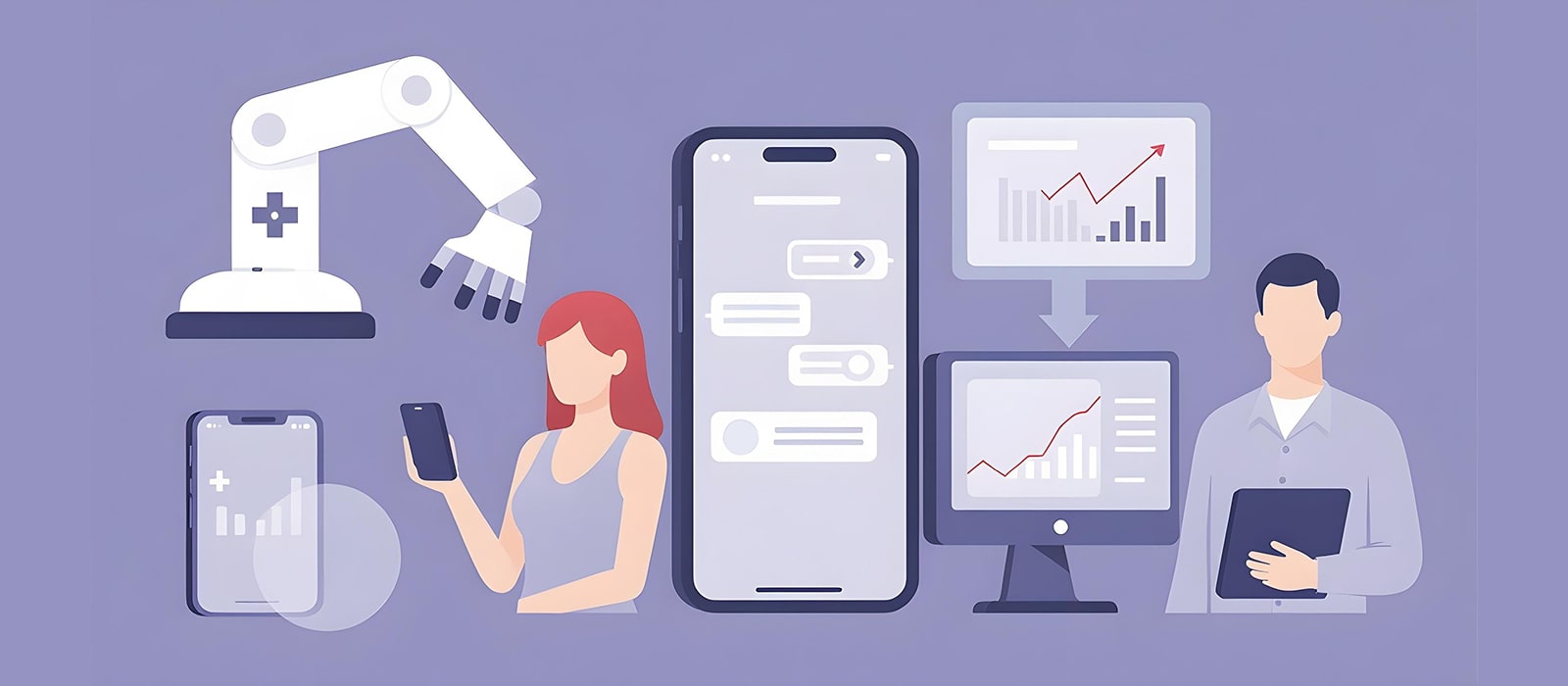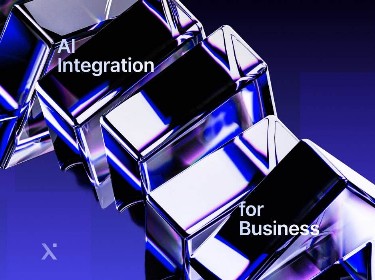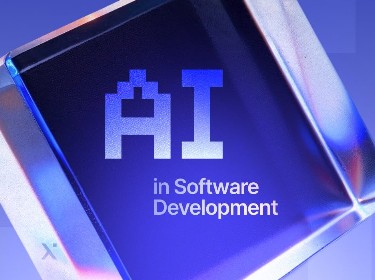Artificial intelligence is now reshaping the digital landscape of businesses across many industries, including trade, finance, and healthcare, leading us into a future of state-of-the-art software able to learn from its mistakes.
Artificial Intelligence (AI) is the simulation of intelligent behavior by software that is programmed to take in new information and learn from it to improve its functionality. Modern AI models and algorithms are based on the concepts of artificial neural networks that mimic our brain’s functions. These models allow AI solutions to take part in the process of data acquisition, interpretation, and decision-making.
AI technology enhances human capabilities, and many businesses have tapped into this resource to increase their efficiency and minimize costs. They are using these new capabilities to improve their products and provide better services. Read on to learn more about AI and its top applications throughout industries.
Artificial intelligence and its types
There are various types of Artificial Intelligence, however, the two main classifications are based on its functionality and its capabilities.
AI types based on capabilities are:
- Artificial narrow intelligence (ANI) is designed to perform a single task or a set of related activities. For instance, this could be analyzing images, searching through large chunks of information to find some insights, speech recognition, or providing recommendations. Almost all AI-systems, as of today, can be classified under this type. Apple’s Siri virtual assistant or Netflix video recommendations are good examples of ANI.
- Artificial general intelligence (AGI) is a level of AI that can perform intellectual and creative tasks with human-like capabilities. It is supposed to make informed decisions based on previous experience and knowledge in related areas. Although there have been some attempts, this type of AI has not yet been fully developed.
- Artificial superintelligence (ASI) is meant to surpass human abilities in analytical thinking, creativity, and performance of completing tasks. We are still a long way from implementing these types of computer systems.
Based on the functionality, the major subfields of AI are described below.
Machine Learning (ML) is the development of an algorithm that can discover patterns and learn from previous data without explicit programming. ML is divided into four main learning approaches: supervised learning, unsupervised learning, semi-supervised learning, and reinforcement learning.
In supervised learning, the algorithm is required to provide answers based on an approved set of information. This type of model is trained using labeled data. With unsupervised learning, the model is trained using unlabeled data that the algorithm must classify and create groups with similar values. The trained model is then used to identify the group that the particular object or value belongs to.
In semi-supervised learning: the reference data used to train the model is incomplete. It uses supervised learning to train from the available labeled data set and unsupervised learning to complete the gaps. Reinforcement Learning is used to train AI systems based on rewards and penalties for the task that the model performs. It’s up to the model, through trial and error, to figure out a pattern that leads to maximum rewards and the least amount of penalties.
Deep learning (DL) uses a broader set of machine learning techniques to work with large arrays of unlabeled data. This data is run through multiple layers of a neural network to categorize and classify data and make predictions. DL is widely used in self-driving cars, image processing and recognition, language processing, and other complex tasks.
Natural language processing (NLP) is the development of computer systems capable of processing human language. The inputted text or audio is translated to a format which the machine understands. The model is trained based on the meaning of certain words, phrases, and lexical constructs that connect them together. For instance, Siri is instructed through speech or text.
Computer vision algorithms are used to recognize objects in images and videos. The model is trained by feeding it a large set of images of an object that needs to be identified. It analyzes images by finding the edges and subcomponents of the object and that way learns what it looks like.
Artificial intelligence application in industries
Artificial intelligence has found its way into many industries out of the need for businesses to automate mundane tasks, as well as to increase the productivity in crucial processes that require working with large sets of information and making precise calculations. Learn about some of AI’s real-life applications from the examples below.
AI in healthcare
![]()
According to a 2021 survey, 19% of healthcare organizations have already implemented AI tools into their work. The prediction is that by 2025 the global market size for AI in healthcare will come to $28 million. The healthcare institutions integrate AI for the purposes of managing patient data records, pinpointing symptoms of diseases in medical images, monitoring medication intake, and other tasks. Having these tools in place allows doctors and higher medical staff to focus on more important issues and treat patients more efficiently.
DeepMind’s health team collaborated with Google Health to design products that aid physicians to improve the quality of patient care. Together these two companies were able to design an AI-based system that identifies breast cancer from mammograms using computer vision. The model outperformed radiologists with the accuracy level increased by 11.5%.
CloudMedX Health is a start-up company that utilizes predictive analytics to improve patient care. The company uses NLP and DL to extract information from electronic patient records and give clinicians a heads-up on the patient’s health status.
Atomwise utilizes AI to predict if a medication will be effective or not based on the drug’s molecular structure. Researchers utilized convolutional neural networks to predict two drugs that could drastically reduce Ebola infectivity. The technology employed allowed the company to analyze the data and make the prediction in one day which would have otherwise conventionally taken months.
AIRA, an AI tool developed by our artificial intelligence and machine learning consulting company, helps to diagnose retinal pathologies from retinal fundus pictures. Machine learning algorithms identify and prove medical staff with information required to determine the presence of pathology. AIRA also contributes to a digital database of retinal pathological cases, thus providing novice ophthalmologists the necessary guidance and support.
Virtual personal assistants
Virtual Personal Assistants (VPA) can give out information such as weather conditions, traffic congestion, news, stock prices, user schedules, retail prices, and much more. Business executives make use of VPAs to make informed decisions, organize and maintain the information, manage emails, calendar events, and to-do lists.
Not surprisingly, AI-based voice assistants are projected to become an $8 billion industry by 2023. As of now, the top Virtual Personal Assistants are Google Assistant and Siri.
Customer service
![]()
Customer service is being modernized through custom AI chatbot development. This software can communicate with clients 24/7 and provide help in troubleshooting, answering questions, and contacting a responsible expert.
AI-powered bots can initiate conversations with customers and continuously track and resolve customer issues. More sophisticated customer service systems utilize AI-powered bots to perform such complex tasks as customer Identification with face and voice recognition, call classification and routing, choosing the tone of speech using emotion analytics, service personalization based on previous requests, etc.
According to Next Move Strategy Consulting, the global chatbot market size is expected to reach $10.29 billion by 2030 with a compound annual growth rate of 29.4%. The top 5 enterprises that already use AI-enabled chatbots for customer service optimization are Apple, Microsoft, Facebook, Disney, and Google.
AI in finance
![]()
AI is reshaping the traditional financial sector through financial forecasting, currency exchange rate prediction, loan approval prediction, fraud detection in financial services, stock price forecasting, and more.
In terms of credit decision, the top companies that implement AI are:
Zest Finance, an AI-based platform that allows users and loaners to make better decisions to increase revenue, reduce risk, and automate compliance. By integrating AI, the company was able to predict risk more accurately, and reduce losses by more than 25%.
DataRobot helps financial institutions and businesses quickly build accurate predictive models that improve decision-making on issues like fraudulent credit card transactions, digital wealth management, direct marketing, Blockchain, lending, and more.
Scienaptic Systems provides an underwriting platform that gives banks and credit institutions more transparency in processing loans while cutting losses by smartly transforming the data, learning from each interaction, and offering contextual underwriting intelligence. Working with one major credit card company, Scienaptic managed to save their loss $151 million in just three weeks.
Enova created AI-based platform Colossus which provides in-depth analytics and suitable technologies for users to acquire loans on the best terms.
Automotive manufacturing and smart vehicles
![]()
Car manufacturers are in a competitive race to develop self-driving cars and autonomous vehicles. A multitude of tech companies and startups are working on integrating AI and machine learning technology to increase the efficiency of car manufacturing and perfect the way autonomous vehicles operate on the road.
Some of the latest uses of AI in the automotive industry are the following:
Autonomous vehicles and self-driving cars
- Aptiv is a global technology company that manufactures vehicles and creates connected solutions and intelligent software that powers its smart car architecture. Their cars can navigate in challenging urban driving environments and have already been put into use by the Lyft ride-hailing service operating in Las Vegas.
- AutoX is a tech company that has mastered the self-driving car manufacturing process from hardware and software to the cloud. They use a combination of machine learning, cloud computing, and big data technologies to prepare their vehicles with real road simulations and virtual generated scenarios. The company has successfully launched its “Robotaxi” ride-hailing service both in China and the US.
- Drive.ai was a promising AI tech startup acquired by Apple for its upcoming driverless car Titan project yet to be publicly introduced. The company designed an AI-based solution and demonstrated a prototype of the vehicle driving autonomously even in the harshest conditions of heavy rain after dark. Their technology used high-definition three-dimensional maps and acute sensors that allowed the self-driving car to easily navigate around other vehicles, pedestrians, and cyclists at low-angle sunlight.
- Optimus Ride is an MIT startup that develops software that runs automated cars in geofenced environments such as industrial parks, college campuses, airports, and residential communities. The company’s Optimus “Virtual Ride Assistant” (VRA) improves the self-driving experience through dynamic interactions between a remote assistance team and the riders.
Vehicle manufacturing
With over 70 million cars being annually produced, carmakers are seeking out modern ways to enhance production. Artificial intelligence is used to revolutionize and automate the manufacturing processes as well.
Rethink Robotics is a startup that designs and deploys low-cost robots to automotive factories. These robots work alongside humans and automate monotonous tasks, including picking out materials, operating machines, and packing finished products.
Datarpm built an algorithm based on machine learning that takes all the information coming from sensors to detect anomalies and optimize performance. The idea is to detect, track, and act upon the identification of any problems in the machines’ operation.
Driver Assist
Driver-assist is used in vehicles utilizing AI-powered advanced driver-assistance systems (ADAS). These systems include automatic braking, driver drowsiness detection, lane departure warning, and other safety features.
Carvi creates driver assistance software that analyzes the driver’s surroundings and the proximity and speed of other vehicles. The software alerts the driver before he changes a lane without using the indicator and also computes its “time to collision” factor to warn against the possible danger of an accident.
Nauto is an AI-based fleet and driver safety platform that predicts and prevents distracted driving. It uses cloud infrastructure and gathers data from edge devices to equip drivers with the tools to make safer decisions on the road.
Space exploration
Astronomers are using AI, specifically machine learning, to sift through data captured by the Kepler telescope to identify distant solar systems. Recently, researchers were able to use AI models to identify a new planet called Kepler-90i – an extremely hot, rocky planet that orbits the Kepler-90 star.
Agriculture
Climate change, crop sustainability issues, and population growth have led agriculture companies to seek more innovative approaches to crop and soil monitoring. AI is predominantly used in field farming, with a market share of more than 60%. It is forecast that AI in agriculture will reach $3.8 billion by 2024.
Blue River Technology and Plantix utilized AI technologies to identify toxicity symptoms and nutrient deficiency in plants and crops.
eAgronom helps to calculate how long particular seeds are to be kept in greenhouses before transplanting them to fields. It not only saves farmers time, but also reduces the use of herbicides and fertilizers by 25-35% and increases yield by 3-4%.
Heliopas, CultYvate, and WaPOR prioritize the issue of water usage. With the help of these applications it is possible to tell the accurate amount of water needed for this or that plant and even check historical irrigation data.
Conclusion
Summing-up, artificial intelligence is advancing and evolving at a tremendous pace. AI solutions have become an indispensable tool for businesses across almost every industry. The technology is optimizing healthcare processes and relieving medical experts from tedious tasks, improving customer service with state-of-the-art chatbot technology, reshaping finance with predictive analytics, transforming transportation with autonomous vehicles, and more. The tip of the spear here is the software architects that craft machine learning models to solve intricate problems and streamline repeatable processes. Ask our qualified experts and data scientists at PixelPlex to bring your idea of integrating AI technology into business to life.




